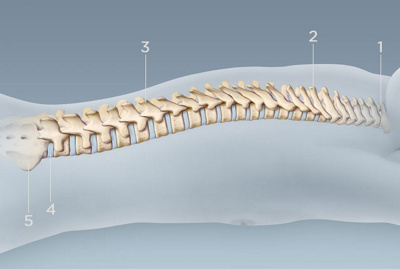Slipped discs are the most common reason for spinal operations. And yet only a small proportion of slipped discs require surgery. Usually all it takes for the disc to heal is conservative therapy and patience.

MRI (magnetic resonance imaging) is the radiological technique used to diagnose slipped or herniated discs (article only available in German and French). Herniated discs are not visible in conventional x-ray images (article only available in German and French). MRI is used to localise the injury, determine the severity of the prolapse and display the affected nerve roots. The examination does not involve x-rays. However, the results are only relevant if they explain the patient’s symptoms. MRI is less suitable for identifying bone deformations, for instance.
Slipped discs in younger patients are rare and present quite differently. If the examining doctor detects any neurological disorders, an MRI examination is carried out to confirm the diagnosis and precisely locate the herniated disc.
Three days of bed rest
The treatment aims to reduce the pain, eradicate any neurological symptoms as well asand help the patient return to work and resume their day-to-day activities.
Most slipped discs resolve themselves naturally. As such, an operation is only advisable if conservative (non-surgical) treatment and waiting have not been successful and/or the neurological symptoms are ongoing.
Ideal conditions for conservative treatment:
• certain forms of sequestered disc
• minor herniated discs
• no or minor neurological symptoms
• minimal sciatic nerve pain
• mild spinal disc deterioration
• young age
Depending on the severity of the symptoms, conservative treatment of a slipped disc in the lumbar region usually involves a maximum of three days in bed, usually with the legs elevated and the hips and knees bent at 90 degrees. This is combined with pain killers, anti-inflammatory medication and physiotherapy.
4,800 herniated disc operations each year
Surgery is advisable if conservative therapy does not lead to any improvement, or if the patient is suffering from severe paralysis. In Switzerland around 4,800 herniated disc operations are performed every year, while in the USA this figure is two and a half times greater per capita.
Hernias are microsurgically removed via a small incision in the middle of the lower back. In contrast, cervical spine operations are usually performed through an incision at the front of the neck.
The operation requires a hospital stay of between three and six days. Afterwards, patients should be able to resume their normal activities within three months. Unfortunately neurological recovery from paralysis cannot be guaranteed, even with a surgical procedure. Endoscopic or laser removal of hernias are only possible in a limited number of cases and the techniques have not yet been conclusively scientifically proven.
Article from Prof.Dr.med Max Aebi, specialist in orthopaedic surgery and traumatology of the musculoskeletal system.
